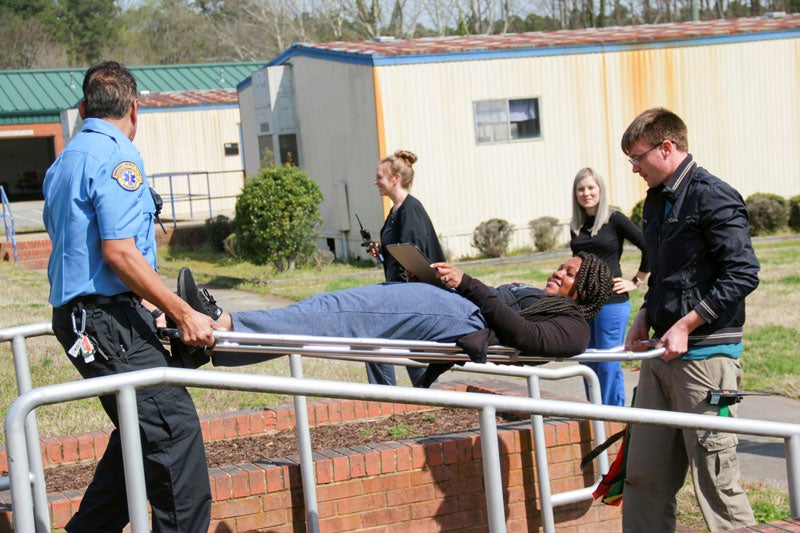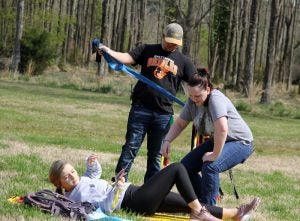PDCCC EMS students participate in mass casualty drill
Published 5:13 pm Friday, April 12, 2019

- Mohammad Sajid, left, and Nick Stickney take “victim” Jameka Burns out on a stretcher. Assistant Professor of Nursing, Simulation and Skills Lab Coordinator Lucy Little and Practical Nursing Faculty Member Laurel Wright are in the background. Submitted | Wendy Harrison
By Wendy Harrison
FRANKLIN

“Victim” Jamie Coggsdale receives help from EMS students Paul Bangley and Charlotte Cifers. Submitted | Wendy Harrison
It was a life threatening scenario at Paul D. Camp Community College’s Franklin Campus this week. A tractor trailer carrying ammonium hydroxide collided with a bus of passengers. Immediate medical help was needed for multiple patients.
Thank goodness this was only a drill.
Fifty nursing and allied health students and faculty participated in Thursday’s Mass Casualty Incident Drill, giving the students some idea of what they would face in a mass casualty situation. Some of the students were assigned injuries as victims while others tended to triage, but everyone had a role. “Patient” conditions ranged from disorientation to bleeding and eye injuries.
“We started off briefing the students before the drill, explaining the hazmat situation and provided them with a map of the “hospital” with designated rooms in the college as emergency areas, such as the operating room and radiology,” explained Associate’s Degree in Nursing (ADN) Program Lead Trudy Kuehn.
EMS Program Director Paul Ruppert gave a separate briefing for the EMS students, highlighting objectives, explaining the triage tagging process, and making them aware of a simulated decontamination area outside near the “victims.’
The students met again near the end of the event for a debriefing and to share what they had learned from the exercise.
“The mass casualty incident allows the nursing students to experience the importance of good communication, teamwork and leadership in a controlled, but chaotic environment,” said Kuehn. “Since hospitals must conduct drills, this is an effective way to replicate a potential situation so that when they are a part of the workforce, they already have a greater understanding.”
According to Ruppert, the exercise also gives his students critical hands-on experience that they will need once out in the field as emergency medical technicians or paramedics.
“In addition, these realistic, full-scale scenarios give students from each of our health sciences disciplines an opportunity to learn from each other,” said Ruppert. “These exercises give our nursing, EMS, and other health sciences students the chance to work cooperatively together to manage critical clinical cases, as is required in real-world medical practice.
“In our joint debriefing sessions after these exercises, it’s clear that our students are gaining a deep understanding and appreciation of the value of each distinct medical specialty as they learn cognitive, psychomotor, and communication skills from each other. This peer-directed active learning, guided by experienced faculty, is a unique feature of education at Paul D. Camp Community College, and is not limited to large scale training exercises. In day-to-day classes, skills labs, and even the interactive workshops our students conduct as an outreach to high school students exploring health sciences careers, the more our students work together in active learning, they more they develop the interpersonal and leadership skills in high demand by employers today,” he said.
For more information about the PDCCC Nursing and Allied Health programs, email Tasha Taylor at ttaylor@pdc.edu.
WENDY HARRISON is the public relations specialist for Paul D. Camp Community College. She can be reached at wharrison@pdc.edu.





